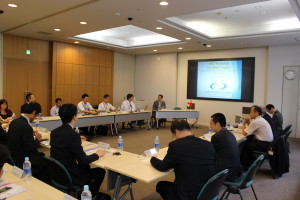The objectives of the initiative are to identify common causes of past large scale blackouts in large cities in Asian countries and possible future risks that could cause major blackouts in large cities and to share best practices for preventing wide area blackouts in terms of power system planning ,operation as well as facility design.
At the workshop, experts from Asian countries including China, Hong Kong, Korea and Japan presented their best practices and future technologies for preventing wide area blackouts. There was also an intensive discussion about how to evaluate the probability and impact of possible future risks and what sort of measures should be taken.
The workshop began with a discussion on the definition of resilience and the difference between reliability and resilience. Resilience comes from the Latin word “resilio”, which literally refers to the ability of an object to rebound or return to its original shape or position after being stressed (bent, compressed, or stretched). In the concept of a power system, it refers to the ability of a power system to recover quickly following a disaster or, more generally, to the ability of anticipating extraordinary and high-impact, low-probability events, rapidly recovering from these disruptive events. It also involves lessons for the future in adapting operations and structures so as to prevent or mitigate the impact of similar events in the future. Adaptation thus refers to the long-term planning and operation measures taken to reduce vulnerability to external sudden shocks.
Mr Shinichi Imai of TEPCO, a leader of this project, said: “It is important to know that resilience is a concept which mainly focusses on low probability/high impact events that includes destruction of the infrastructure itself and which needs to be evaluated in the recovery period after the event. On the other hand, reliability is a conventional concept which focuses on high probability/lower impact events and only needs to be evaluated in terms of customer interruption time. Reliability is a static issue, but resilience is ongoing and an adaptive issue.
In other words, we need to distinguish blackouts from disaster. A blackout occurs when a large portion of a power grid is disabled by a combination of unplanned contingencies, resulting in a temporary power interruption. A reliable and well-designed power system should be capable of minimising the amount of power disruption and of recovering very quickly from a blackout. On the other hand, a disaster, which usually includes blackouts, refers to severe and rapidly changing circumstances possibly never before experienced. A disaster can cause the incapacitation of several and often large parts of a power grid, which may last for a long period depending on the extent of the disaster. Hence, a power infrastructure that can maintain high levels of performance under any conditions should be reliable in the most “common” blackouts, but also resilient to much less frequent disasters."
In closing the workshop, Imai made the following points: “In the 20th Century, most of the large blackouts were caused by accidental destruction by third parties or operational inaccuracy. However, in the 21st Century, more blackouts due to abnormal weather conditions are occurring more frequently.
“Utilities are highly recommended to have a “Probability /Impact Risk Assessment” scheme (Priority = Probability of worst case scenario * Impact on power supply) in order to prioritise the measures that need to be taken to avoid possible risks. This assessment process should be repeated every year in a manner of PDCA (Plan-Do-Check-Action) cycle.
“Measures to be recommended should be classified into three categories, such as “Hardening/Reinforcement Measures”, “Smart/Operational Measures” and “Hybrid Measures”.
The final report will be presented at the Asia Regional Meeting in Addis Ababa, Ethiopia, in October.






_-80_result_688_387_s_c1_c_c.jpg)


